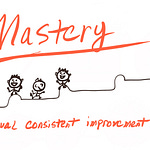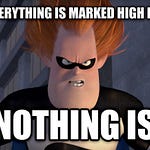Alas, we find ourselves in the 21st century!
Warning - this article is not aimed explicitly at buzzword compliance. It’s just hard to tell the story of today without the proper language.
We’ve journeyed a long way to get here, from artisanal production to machine tools, to mass production, to lean production of both atoms and bits. It’s taken us a few hundred years since the start of our hockey stick, and we continue to crush it to this very day.
How are we crushing production today?
These days, whether we’re talking about digital products that let us buy physical products (like Etsy or Amazon), physical produce quantities being updated in real-time within a store (Walmart) and even within other digital product platforms (Instacart), the idea of a product is harder to track than ever before.
Lines between products and services are blurring as well: consider the product-service system (yes, this is a thing - systems thinking, right!). Copy machines are the canonical example here. No one actually buys a commercial copy machine anymore (or the ink cartridges for that matter). But they do buy the service of being able to make copies. This is a business model innovation that strikes at the heart of value creation through production and productivity.
When we make physical goods now, we want to track each and every single one with a unique digital signature; think blockchains and digital twins.
When we make digital art, we want to track its uniqueness like physical art through Non Fungible Tokens (NFTs). Is there value here? Absolutely. Just ask Gary Vee.
To get fully immersive digital Virtual Reality (VR) experiences, inside-the-video game status, we need hardware to physically put on our bodies to help us transport to these virtual worlds. The overlap between the physical and digital worlds is even more apparent when it comes to Augmented Reality (AR) tech. Apparently, you can even work at a supermarket with the metaverse today with robots, which seems to be taking AR even one step further.

Zooming out on the life and death of products, when we consider entire product life cycles at the bleeding edge of physical and digital technologies, we see concepts like smart manufacturing and machine learning operations (MLOps), which both rely heavily on many interfaces between the physical and digital worlds.

The best example of such an interface between the physical and digital world is a sensor or Internet of things (IoT) device that is constantly collecting data and using it to inform your digital computer models, which in turn automatically improve their ability to predict what’s going to happen in the physical world. Whether your models leverage classical “physics-based” simulations or simply capture the physics of the problem through data (in other words, AI), the essence of what is occurring is feedback from the physical to the digital realm.
These interfaces are critical when it comes to making great products today, especially when you consider the entire product lifecycle.
And, there’s even a cool word for this fusion between the physical and digital worlds now: phygital.
The 21st century has, it would appear, a lot to teach us about products.
Speaking of teaching and products, when does an online course become simply a digital product? I digress - we will pick up this thread soon enough in the coming weeks and months.
An (actual) Brief History of Product
At the very beginning of this series, we learned that product means to lead or bring forth into being or existence.
Throughout this series, we’ve seen products evolve in many ways, from atoms to artisans, from machine tools to factories full of them, from assembly lines to profound systems thinking, from physics to business, and from the shop floor to Silicon Valley.
But what has remained the same throughout?
The fundamental transformation at the center of product(ion) is value creation itself.
When humans evolved from monkeys with simple tools to artists, we started taking raw materials (say, a rock) and transforming them into more than what they were (say, a coconut opener).
A chair is just pieces of stuff until you sit on it.
Atoms are just atoms and bits are just bits, until you make something happen with them. Something that makes things better/faster/cheaper than what they were.
Matter itself must be leveraged to bring about what matters.
That’s production.
So you see, our brief history of product leads back to the universe of markets and the driving force behind them.
Value Creation in a Nutshell
Speaking of markets, didn’t we start off this series talking about Etsy, the marketplace?
We left off in our discussion having articulated that Etsy is a platform made up of a suite of digital products that help buyers and sellers to exchange physical (and now even sometimes phygital or purely digital) products in our first article with a question:
Where are the people and their useful work in this picture of digital products?
Now we have our answer.
They’re in the same place that they’ve always been.
That is, at the intersection of less value and more value. Creating. And solving problems.
They’re applying physical principles of our world to manipulate matter and turn it into what matters.
To engineer simply means to apply physical principles to the world.
Just because engineers in Silicon valley use their hands (the greatest tools of all) to interact with our world by making keystrokes on a keyboard while engineers in the MidWest … well, I guess they do the same thing don’t they?
And despite likely having different job titles, they probably both have to turn a wrench or two from time to time, even if it’s just a small electronics-sized one.
In the end, while production might lead to different tools with which we strive to create value in the universe, the core principle remains the same.
Take stuff as it is, and make it better than it was.
Yay consciousness. Yay humans. Yay progress. And Yay product(ion).
On Entrepreneurship
We closed out the last article by mentioning that the tradition of lean led us to Steve Blank, Eric Ries, the lean startup, and the startup way.
Question: what makes a startup or company lean?
Answer: a relentless focus on the highest leverage activities that create value
Question: what do startups and companies actually use to create value?
Answer: Minimum Viable Products, MVPs
Question: Whose job is it to relentlessly focus on creating value?
Answer: Product managers and leaders
Question: What are product management and leadership?
Answer: In short; the tactics of entrepreneurship.
Question: What companies have created the most value in the world?
Answer: The ones whose CEOs are also product visionaries.
Question: Is there any difference between a company’s vision and its first product vision?
Answer: No. Consider Google’s original product vision that is now its corporate vision: to provide access to the world’s information in one click.
Be a Meta-Maker
That’s all folks!
You should have everything you need to talk “product” with just about anyone.
And remember, being a meta maker means that you’re a fearless builder of hardware, software, and community. It means that you’ve cultivated the power to think, speak, write, and crucially, that you’re capable of aligning utility with beauty to create - that’s right! - value, for yourself and for others.
Don’t consume. Create (value, for others). Produce. Make. Become #unautomatable.












